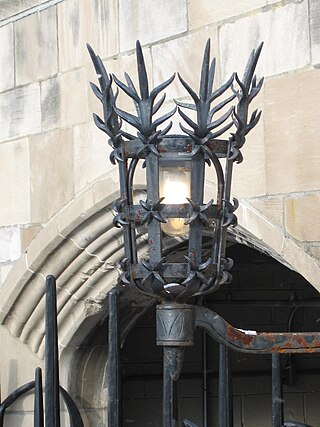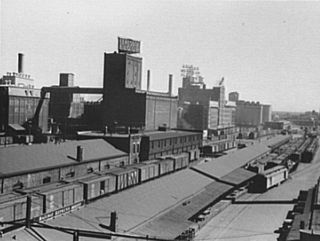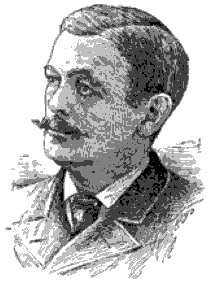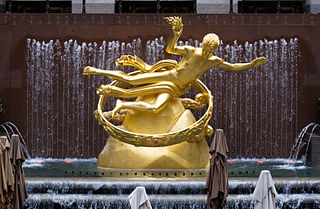
Flour City Ornamental Iron Works Company was an early pioneer in the manufacturing of architectural wrought and cast iron building components. [1] [2]

Flour City Ornamental Iron Works Company was an early pioneer in the manufacturing of architectural wrought and cast iron building components. [1] [2]
Flour City Ornamental Iron Works Company was founded by Eugene Tetzlaff in 1893 in Minneapolis, Minnesota. The company was originally a blacksmith shop, but later, it became a manufacturer of wrought and cast iron. [3] [4]
During World War II, Flour City produced aluminum bridge pontoons and aircraft parts. In 1945, Henry J. Neils, first president of the Flour City Ornamental Iron Works Company, began production of aluminum boats. The first aluminum boat produced by Flour City subsidiary, Alumacraft, came off the production line in 1946. Hupp Corporation bought Alumacraft from Flour City, in 1960. [5]
Flour City Ornamental Iron Works, later known as Flour City Architectural Metal Works, continued its production of ornamental and architectural metal products. In the early 1990s, Flour City became a part of Flour City International, Inc., and its headquarters moved from Minnesota to Tennessee. [6]

Minoru Yamasaki was a Japanese-American architect, best known for designing the original World Trade Center in New York City and several other large-scale projects. Yamasaki was one of the most prominent architects of the 20th century. He and fellow architect Edward Durell Stone are generally considered to be the two master practitioners of "New Formalism".

The Foshay Tower, now the W Minneapolis – The Foshay hotel, is a skyscraper in Minneapolis, Minnesota. Modeled after the Washington Monument, the building was completed in 1929, months before the stock market crash in October of that year. It has 32 floors and stands 447 feet (136 m) high, which made it the tallest building in the Midwest for 48 years. plus an antenna mast that extends the total height of the structure to 607 feet (185 m). The building, which was added to the National Register of Historic Places in 1978, is an example of Art Deco architecture. Its address is 821 Marquette Avenue, although it is set well back from the street and is actually closer to 9th Street than Marquette.

Samuel Yellin (1884–1940), was an American master blacksmith, and metal designer.

Minneapolis City Hall and Hennepin County Courthouse, designed by Long and Kees in 1888, is the main building used by the city government of Minneapolis, as well as by Hennepin County, in the U.S. state of Minnesota. The structure has served as mainly local government offices since it was built, and today the building is 60 percent occupied by the city and 40 percent occupied by the County. The building is jointly owned by the city and county and managed by the Municipal Building Commission. The Commission consists of the chair of the County Board, the mayor of the City of Minneapolis, a member of the County Board and a member of the Minneapolis City Council. The County Board chair serves as the president of the Commission and the mayor serves as the vice president. The building bears a striking resemblance to the city hall buildings in Cincinnati and Toronto. The City Hall and Courthouse was added to the National Register of Historic Places in 1974.
Ellerbe Becket was an independent Minneapolis, Minnesota-based architectural, engineering, interior design and construction firm until 2009, when it was acquired by AECOM.
Purcell & Elmslie (P&E) was the most widely know iteration of a progressive American architectural practice. P&E was the second most commissioned firm of the Prairie School, after Frank Lloyd Wright. The firm in all iterations was active from 1907 to 1921, with their most famous work being done between 1913 and 1921.

Northwestern Consolidated Milling Company was an American flour milling company that operated about one-quarter of the mills in Minneapolis, Minnesota, when the city was the flour milling capital of the world. Formed as a business entity, Northwestern produced flour for the half-century between 1891 and 1953, when its A Mill was converted to storage and light manufacturing. At its founding, Northwestern was the city's and the world's second-largest flour milling company after Pillsbury, with what is today General Mills a close third. The company became one of three constituents of a Minneapolis oligopoly that owned almost nine percent of the country's flour and grist production and products by 1905. This occurred as a result of their attempt at a United States monopoly.

The Woodbury County Courthouse is located at 620 Douglas Street in Sioux City, the county seat of Woodbury County, Iowa, United States. It is regarded as "one of the finest Prairie School buildings in the United States" and has been declared a National Historic Landmark for its architecture. It is used for legal proceedings in the county.

Metals used for architectural purposes include lead, for water pipes, roofing, and windows; tin, formed into tinplate; zinc, copper and aluminium, in a range of applications including roofing and decoration; and iron, which has structural and other uses in the form of cast iron or wrought iron, or made into steel. Metal alloys used in building include bronze ; brass ; monel metal and nickel silver, mainly consisting of nickel and copper; and stainless steel, with important components of nickel and chromium.

Save America's Treasures is a United States federal government initiative to preserve and protect historic buildings, arts, and published works. It is a public–private partnership between the U.S. National Park Service and the National Trust for Historic Preservation. The National Endowment for the Arts, National Endowment for the Humanities, and Institute of Museum and Library Services are also partners in the work. In the early years of the program, Heritage Preservation and the National Park Foundation were also involved.

Emmanuel Louis Masqueray (1861–1917) was a Franco-American preeminent figure in the history of American architecture, both as a gifted designer of landmark buildings and as an influential teacher of the profession of architecture dedicated to the principles of Beaux-Arts architecture.
George Earl Ortman was an American painter, printmaker, constructionist and sculptor. His work has been referred to as Neo-Dada, pop art, minimalism and hard-edge painting. His constructions, built with a variety of materials and objects, deal with the exploration off visual language derived from geometry—geometry as symbol and sign.

Milton Earle Beebe was an American architect who designed numerous buildings in Buffalo, New York, in Fargo, North Dakota, and elsewhere. He designed courthouses "at Warren, Smethport, Cambria, and Huntingdon in Pennsylvania, costing $100,000 each." Several are listed on the National Register of Historic Places. He also designed Early Commercial architecture buildings, residences, churches and public buildings.

Carl F. Struck was a Norwegian American architect, who designed private residences, civic buildings and commercial structures throughout the Midwest in the latter part of the 19th century.
EverGreene Architectural Arts (EverGreene) is the largest specialty contractor in the U.S., providing design, restoration, conservation, and adaptive reuse services to commercial, government, institutional, sacred, and theater clients. Established in 1978 by Jeff Greene, EverGreene has grown from a small mural painting studio to a company of artists, conservators, craftsmen, and designers that work throughout the United States and abroad.

Françoise Grossen is a textile artist known for her braided and knotted rope sculptures. She lives and works in New York City. Grossen’s work has been acquired by the Metropolitan Museum of Art, New York; the Renwick Gallery, Smithsonian American Art Museum, Washington, DC; and the State Hermitage Museum, Saint Petersburg, Russia.

The Art Deco style, which originated in France just before World War I, had an important impact on architecture and design in the United States in the 1920s and 1930s. The most notable examples are the skyscrapers of New York City, including the Empire State Building, Chrysler Building, and Rockefeller Center. It combined modern aesthetics, fine craftsmanship, and expensive materials, and became the symbol of luxury and modernity. While rarely used in residences, it was frequently used for office buildings, government buildings, train stations, movie theaters, diners and department stores. It also was frequently used in furniture, and in the design of automobiles, ocean liners, and everyday objects such as toasters and radio sets.

Purdy and Henderson was a New York City-based engineering firm founded by Corydon Tyler Purdy and Lightner Henderson. They were active in the United States and Cuba between 1890 and 1944.
The General Bronze Corporation was an American metals fabricator, primarily of bronze and aluminum, and the most recognized company in the architectural bronze and aluminum industry during the first half of the 20th century. It was known for New York City's Seagram Building on Park Avenue designed by Mies van der Rohe, the Atlas and Prometheus bronze sculptures in Rockefeller Center, the bronze doors for the United States Supreme Court, Commerce, and Department of Justice Buildings in Washington, DC, the aluminum windows for the United Nations Secretariat Building and Chase Manhattan Bank Building, and for the design of the Arecibo Radio Telescope suspension system. As American cities evolved, the need for architectural and sculptural bronze increased. An innovative and progressive company, General Bronze Corporation stepped up to supply that demand. It became the dominant leader in the architectural bronze industry for both bronze fabrication and bronze sculpture, and aluminum fabrication in the United States for over three decades. In the early 1950s, General Bronze was also at the forefront of the fledgling television radio industry as a major manufacturer of radio antennas, and one of the first to introduce automatic motorized antennas for the automobile industry. General Bronze's Brach Manufacturing subdivision offered electronics to the early radio telescope field, such as the Green Bank Telescope of the National Radio Astronomy Observatory in Green Bank, West Virginia and the Arecibo Radio Telescope.